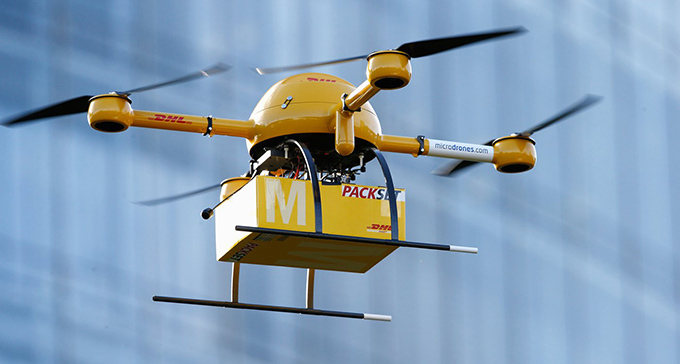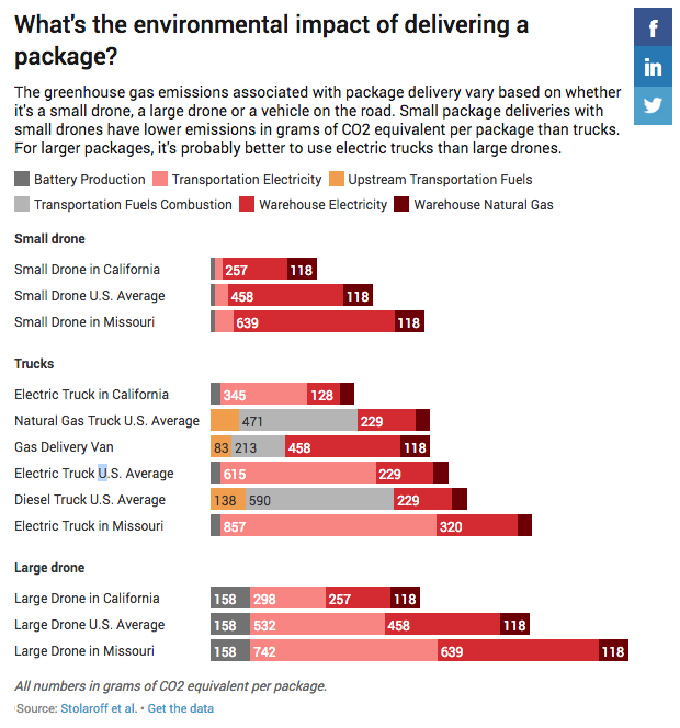
There are more than 1 million drones registered in the U.S. Most of them belong to people flying them for fun, but a growing number are used commercially. Companies including Amazon, UPS, Google and DHL are already exploring ways to deliver packages with drones instead of trucks. Our new research has measured how that shift would change how the U.S. uses energy, and the resulting environmental effects.
We found that in some cases using electric-powered drones rather than diesel-powered trucks or vans could reduce energy use and greenhouse gas emissions. But in other cases, using trucks – especially electric-powered ones – would be more efficient and cleaner.
The U.S. electricity sector has been rapidly transitioning to generating power with fewer greenhouse gas emissions. But transportation is still largely powered by fuels made from oil and is now the largest source of greenhouse gas emissions in the U.S. About one-quarter of transportation emissions, the equivalent of 415 million metric tons of carbon dioxide, comes from medium- and heavy-duty trucks, the kinds of vehicles that deliver freight to warehouses, businesses and consumers’ homes.
Reducing the need for trucking by delivering some packages with electric drones could save fuel, and potentially carbon emissions. We modeled how much energy drone delivery would use, and how it would be different from the ways packages are delivered now.
Finding a drone’s energy use
First, our team – led from Lawrence Livermore National Laboratory, and including researchers from Carnegie Mellon University, SRI International and the University of Colorado–Boulder – measured the energy use of quadcopter and octocopter-style drones carrying different payloads. The amount of energy a drone uses depends on how heavy the drone itself is, its batteries and whatever packages it’s carrying – as well as other factors, including how fast it’s moving and wind conditions.
For the purposes of making an overall estimate, we settled on a quadcopter drone capable of delivering a 1.1 pound (0.5 kg) package and an octocopter drone capable of delivering a 17.6 pound (8 kg) package, each with a range of about 2.5 miles (4 km). We considered a range of battery technologies and fuels, but focused on lithium-based batteries for our base case, because that’s what powers most current electric drones.
Comparing emissions
Even though it’s fighting gravity to stay aloft, an electric drone uses much less energy per mile than a heavy steel delivery truck burning diesel fuel. But a delivery truck or van can carry many packages at once, so the energy needs and environmental effects need to be allocated per package.
Different delivery vehicles can run on diesel, natural gas, electricity or gasoline, each with various energy and emissions characteristics. We also included the environmental effects of making these fuels and of making electric vehicle batteries. The energy needed to turn crude oil into diesel fuel can add another 20 percent or more of greenhouse gases to the amount generated when the fuel is burned. And while battery manufacturing is improving, making batteries still generates carbon dioxide.
Then we calculated the amount of greenhouse gases emitted. Burning a gallon of diesel fuel emits about 10 kg of carbon dioxide, but emissions from electricity vary by region, depending on how it’s generated. Some areas burn more coal and natural gas to generate power, while others have fewer fossil fuels and rely more on nuclear, hydropower, wind and solar power.
In general, electric power generation in the U.S. is getting cleaner over time. To show the range of energy needs and environmental effects, we paid particular attention to California, which has a low-carbon grid, and Missouri, which is in a carbon-intensive region.
Extra warehouses?
In addition, to serve drones with limited range, companies would have to change how their delivery systems use energy. Drones could transport items in multiple legs, almost like the Pony Express or stagecoaches did with horses in the early days of the American West. Or, as Amazon is testing, smaller local warehouses could serve key delivery destinations within the drones’ range.
We calculated that serving the city of San Francisco would require about four urban warehouses with drone bases. To cover the greater Bay Area would require dozens of new warehouses, each needing electricity and potentially natural gas to operate, just like other warehouses. We included this extra energy use in our estimates.
Small drone delivery can save emissions
Combining all the factors, we found that package delivery with small drones can be better for the environment than delivery with trucks. On average in the U.S., truck delivery of a package results in about 1 kg of greenhouse gas emissions. In California, drone delivery of a small package would result in about 0.42 kg of greenhouse gas emissions. That’s a savings of 54 percent from the 0.92 kg of greenhouse gases associated with a package delivered by truck in that state. In carbon-intensive Missouri the improvement would be smaller – just a 23 percent reduction – but still better.
Small drones were better than any truck or van, whether powered by diesel fuel, gasoline, natural gas or even electricity.
Our findings about larger drones were less clear-cut. They were 9 percent better than than diesel trucks when in California, but a lot worse when charged in Missouri. Because large drones need more kilowatt-hours to fly a mile, the carbon intensity of electricity really matters for large drones. Even in places where energy is typically generated from clean sources, it’s probably better to deliver larger packages with electric vans or electric trucks rather than large drones, because of the extra warehouse energy needed for drones.
But if you forgot that essential ingredient for tonight’s dinner, our findings suggest it’s much better to have the grocery store send it to you by drone rather than to take your car to the store and back.

Next steps for sustainability
Like any energy model, our estimates can change depending on the assumptions used. The amount of space needed to store packages for drones, and how much energy drones use, are important factors, as is the carbon footprint of the electricity used. In our paper, we explore how the results change under different assumptions.
For ground delivery vehicles, the best ways to improve efficiency involve increasing the number of packages delivered per mile or switching to electric delivery trucks or vans.
As more companies start using drones, package delivery will be one of their tasks. To maximize the potential environmental benefits, companies should focus on using smaller drones charged with low-carbon electricity to deliver light packages, and on limiting how much warehouse space is dedicated to serving delivery drones. Heavier packages are likely best suited for efficient, often electric, ground delivery vehicles. The biggest gains will come from improving warehouses’ energy efficiency and, crucially, reducing the amount of electricity generated from carbon-intensive fuels. Now we just have to do something about the noise of all those propellers overhead.
Author Bios: Constantine Samaras is Assistant Professor of Civil and Environmental Engineering at Carnegie Mellon University and Joshuah Stolaroff is an Environmental Scientist at Lawrence Livermore National Laboratory
